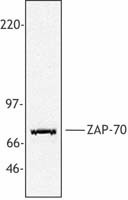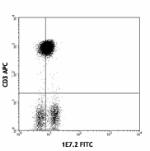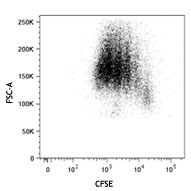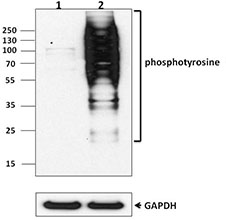- Clone
- 1E7.2 (See other available formats)
- Regulatory Status
- RUO
- Other Names
- Zeta chain associated protein kinase, SYK related tyrosine kinase
- Isotype
- Mouse IgG1, κ
- Ave. Rating
- Submit a Review
- Product Citations
- publications

-

Jurkat cell extract was resolved by electrophoresis, transferred to nitrocellulose, and probed with monoclonal anti-ZAP-70 antibody. Proteins were visualized using a goat anti-mouse secondary conjugated to HRP and a chemiluminescence detection system.
| Cat # | Size | Price | Quantity Check Availability | Save | ||
|---|---|---|---|---|---|---|
| 313402 | 100 µg | 147€ | ||||
ZAP-70 is a 70 kD protein tyrosine kinase associated with the zeta chain of the T cell receptor. It is expressed in T cells and NK cells and has been shown to be involved in T cell signaling. Defects in ZAP-70 have been linked to selective T cell defects. The ZAP-70 kinase undergoes multiple phosphorylation events after T cell receptor engagement and interacts with a number of proteins involved in signal transduction. Recently, ZAP-70 has been identified as an important prognostic marker in B-cell chronic lymphocytic leukemia (B-CLL). The 1E7.2 monoclonal antibody recognizes human and mouse ZAP-70 and has been shown to be useful for flow cytometry, Western blotting, and immunoprecipitation.
Product DetailsProduct Details
- Verified Reactivity
- Human, Mouse
- Antibody Type
- Monoclonal
- Host Species
- Mouse
- Immunogen
- GST-fusion protein corresponding to residues 282-307 of human ZAP-70
- Formulation
- Phosphate-buffered solution, pH 7.2, containing 0.09% sodium azide.
- Preparation
- The antibody was purified by affinity chromatography.
- Concentration
- 0.5 mg/ml
- Storage & Handling
- The antibody solution should be stored undiluted between 2°C and 8°C.
- Application
-
ICFC, WB - Quality tested
IP - Reported in the literature, not verified in house - Recommended Usage
-
Each lot of this antibody is quality control tested by intracellular immunofluorescent staining with flow cytometric analysis or Western blotting. For flow cytometric staining, the suggested use of this reagent is ≤ 0.5 µg per 106 cells in 100 µl volume. For Western blotting, the suggested working dilution(s)is 0.5-1 µg/ml. It is recommended that the reagent be titrated for optimal performance for each application.
- Application Notes
-
Additional reported applications (for the relevant formats) include: immunoprecipitation2, Western blotting2.
This product is for in vitro research use only. It is not to be used for commercial purposes. Use of this product to produce products for sale or for diagnostic, therapeutic or drug discovery purposes is prohibited. In order to obtain a license to use this product for commercial purposes, contact The Regents of the University of California. -
Application References
(PubMed link indicates BioLegend citation) - Product Citations
-
- RRID
-
AB_314995 (BioLegend Cat. No. 313402)
Antigen Details
- Structure
- Protein tyrosine kinase, contains two SH2 domains, 70 kD
- Distribution
-
T cells, NK cells, B-cell chronic lymphocytic leukemia (B-CLL)
- Function
- Signal transduction, associates with the T-cell antigen receptor zeta chain tyrosine-based activation motif when phosphorylated. Defects in ZAP-70 causes selective T cell defect
- Ligand/Receptor
- Binds to CD3 zeta chain, also associates with a variety of proteins including SLA, Fyn, RasGap, Lck, Vav1, and Shc
- Modification
- Multiple phosphorylation sites (Tyr319 phosphorylation essential for full activity)
- Cell Type
- Leukemia, NK cells, T cells
- Biology Area
- Cell Biology, Immunology, Signal Transduction
- Molecular Family
- Protein Kinases/Phosphatase, TCRs
- Antigen References
-
1. Chan AC, et al. 1992. Cell 71:649.
2. Chan AC, et al. 1994. Science 264:1559.
3. Arpaia E, et al. 1994. Cell 76:947. - Gene ID
- 22637 View all products for this Gene ID 7353 View all products for this Gene ID
- UniProt
- View information about ZAP-70 on UniProt.org
Related FAQs
Other Formats
View All ZAP-70 Reagents Request Custom Conjugation| Description | Clone | Applications |
|---|---|---|
| Purified anti-human/mouse ZAP-70 | 1E7.2 | ICFC,WB,IP |
| PE anti-human/mouse ZAP-70 | 1E7.2 | ICFC |
| FITC anti-human/mouse ZAP-70 | 1E7.2 | ICFC |
Customers Also Purchased
Compare Data Across All Formats
This data display is provided for general comparisons between formats.
Your actual data may vary due to variations in samples, target cells, instruments and their settings, staining conditions, and other factors.
If you need assistance with selecting the best format contact our expert technical support team.
-
Purified anti-human/mouse ZAP-70

Jurkat cell extract was resolved by electrophoresis, transfe... -
PE anti-human/mouse ZAP-70

Human peripheral blood lymphocytes were surface stained with... 
Human peripheral blood lymphocytes were surface stained with... 
Human peripheral blood lymphocytes were treated with True-Nu... -
FITC anti-human/mouse ZAP-70

Human peripheral blood lymphocytes intracellularly stained w...
 Login / Register
Login / Register 











Follow Us